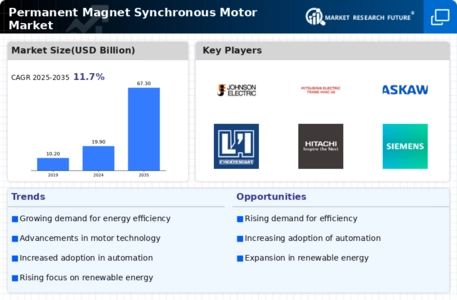Rising Demand for Energy Efficiency
The Permanent Magnet Synchronous Motor Market is experiencing a notable surge in demand for energy-efficient solutions. As industries strive to reduce operational costs and minimize environmental impact, the adoption of permanent magnet synchronous motors is becoming increasingly prevalent. These motors are known for their high efficiency, often exceeding 90%, which translates to significant energy savings. According to recent data, the energy efficiency of these motors can lead to a reduction in energy consumption by up to 30% compared to traditional induction motors. This trend is likely to drive the market forward, as businesses seek to comply with stringent energy regulations and enhance their sustainability profiles.
Expansion of Automation in Industries
The Permanent Magnet Synchronous Motor Market is experiencing growth due to the increasing automation across various sectors. Industries such as manufacturing, logistics, and agriculture are increasingly adopting automated systems to enhance productivity and efficiency. Permanent magnet synchronous motors are integral to these systems, providing precise control and high performance. The automation market is projected to grow significantly, with estimates suggesting a compound annual growth rate of over 10% in the next few years. This expansion is expected to create a substantial demand for permanent magnet synchronous motors, as companies seek to implement advanced technologies that improve operational efficiency and reduce labor costs.
Growth in Electric Vehicle Production
The Permanent Magnet Synchronous Motor Market is poised for growth, largely driven by the escalating production of electric vehicles (EVs). As the automotive sector transitions towards electrification, the demand for efficient and compact motors is intensifying. Permanent magnet synchronous motors are favored in EV applications due to their high torque density and performance characteristics. Recent statistics indicate that the electric vehicle market is projected to grow at a compound annual growth rate of over 20% in the coming years. This growth is expected to significantly bolster the demand for permanent magnet synchronous motors, as manufacturers seek to enhance vehicle performance and efficiency.
Increased Investment in Renewable Energy
The Permanent Magnet Synchronous Motor Market is significantly influenced by the rising investment in renewable energy sources. As countries and corporations prioritize sustainable energy solutions, the demand for efficient motors in wind turbines and solar energy systems is on the rise. Permanent magnet synchronous motors are particularly well-suited for these applications due to their high efficiency and reliability. Recent reports suggest that investments in renewable energy are expected to reach trillions of dollars over the next decade, creating a robust market for motors that can operate effectively in these environments. This trend is likely to drive innovation and expansion within the permanent magnet synchronous motor sector.
Advancements in Manufacturing Technologies
The Permanent Magnet Synchronous Motor Market is benefiting from advancements in manufacturing technologies, which are enhancing the production capabilities and reducing costs. Innovations such as additive manufacturing and improved magnet production techniques are enabling manufacturers to create more efficient and reliable motors. These advancements not only streamline the production process but also contribute to the overall performance of the motors. As a result, the market is likely to witness an influx of new products that meet the evolving needs of various industries. The ability to produce high-quality motors at lower costs may further stimulate market growth, attracting new players and expanding applications.


















Leave a Comment